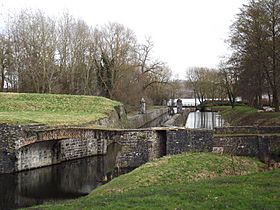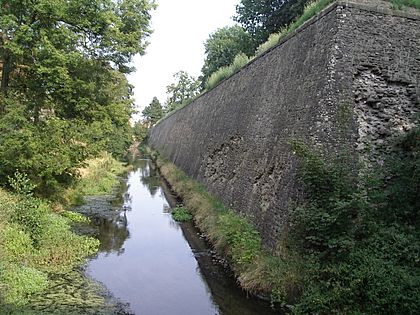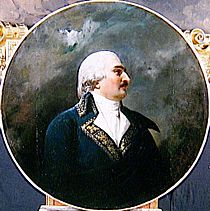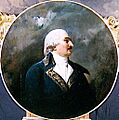Siege of Condé (1793) facts for kids
Quick facts for kids Siege of Condé (1793) |
|||||||
|---|---|---|---|---|---|---|---|
| Part of the Flanders campaign in the War of the First Coalition | |||||||
 The defenses of Condé included ditches that could be flooded via sluice gates. |
|||||||
|
|||||||
| Belligerents | |||||||
| Commanders and leaders | |||||||
| Strength | |||||||
| 6,000 | 4,300 | ||||||
| Casualties and losses | |||||||
| light | 4,300, 103 guns | ||||||
The Siege of Condé happened from April 8 to July 12, 1793. It was a battle where soldiers from Austria and French Royalists surrounded the town of Condé. They were led by Duke Ferdinand Frederick Augustus of Württemberg. Inside the town, a Republican French army was defending, led by Jean Nestor de Chancel. After about three months, the French soldiers inside the fortress had to give up. This event was part of the War of the First Coalition, which was a bigger conflict known as the French Revolutionary Wars. The town of Condé-sur-l'Escaut, France, is located close to the Belgium border. It's about 14 kilometers (9 miles) northeast of Valenciennes.
In mid-March, the Austrians won a battle at Neerwinden. This forced the French army to leave the Austrian Netherlands. After this, a French general named Charles François Dumouriez switched sides. This made many French soldiers lose hope and made politicians suspicious of their generals. Austria and its allies then attacked the strong fortresses protecting France's northeastern border. They first surrounded Condé, and then Valenciennes soon after. Meanwhile, the French armies were a mix of experienced soldiers and new recruits. Their generals were also worried about being accused of treason. They struggled to defend their country.
Contents
Why Did the Siege of Condé Happen?
On March 18, 1793, the French army, led by Charles François Dumouriez, attacked the Austrian army. The Austrians were led by Prince Josias of Saxe-Coburg-Saalfeld at the Battle of Neerwinden. The French had about 40,000 foot soldiers and 4,500 horse soldiers. The Austrians had 30,000 foot soldiers and 9,000 horse soldiers. The fighting was very tough in the middle and on the right side of the French army. But the French left side broke apart and ran away.
After another defeat near Leuven on March 21, the French left Brussels on March 24. Many of their soldiers deserted, meaning they left the army. General Dumouriez then talked with the Austrians. He agreed to leave the Austrian Netherlands if his troops could pass safely. The French armies then took positions behind their own border. The Army of Holland went near Lille, the Army of the Ardennes went to Maulde, and the Army of the North went to Bruille-Saint-Amand. The Army of Belgium was positioned at Condé-sur-l'Escaut and Valenciennes.
General Dumouriez's Plan
Dumouriez secretly supported the idea of a king, even though King Louis XVI had been put to death on January 21, 1793. Dumouriez planned to march his army to Paris and overthrow the government, called the National Convention. He made a deal with the Austrians. They would not invade France while its borders were unprotected. On April 1, the War Minister and government officials arrived at his headquarters. They wanted answers from him. Dumouriez arrested them and gave them to the Austrians.
However, his plan quickly failed. His supporters could not take control of the border fortresses. In one event, a group of French volunteers even fired on Dumouriez. While some cavalry and regular soldiers might have joined his plan, the artillery and volunteers were loyal to the Revolution. They refused to follow him. On April 5, 1793, Dumouriez left France and joined the Austrians. With his plan ruined, the Austrians started fighting again.
Condé's Strong Defenses
Condé-sur-l'Escaut is in a very important spot. It's where the Scheldt (Escaut) and Haine Rivers meet. The ancient Romans knew this when they built a town there. Over time, people built strong defenses around Condé. By the end of the Middle Ages, it had stone walls and towers, surrounded by a moat.
The Spanish tried to make the defenses better in 1654. But the French general Henri de la Tour d'Auvergne, Vicomte de Turenne captured the town the next year. After France gave Condé back to Spain in 1659, the Spanish turned it into a true fortress. They built new strong walls with pointed sections called bastions around the town. The old wall stayed as an inner defense. At first, these new defenses were made of earth. But in 1666, the bastions on the west side were covered with stone. On the south side, a special defense called a hornwork was built to protect the old town castle. If attacked, the defenders could easily fill the ditch with river water.
In April 1676, a French army surrounded the town. Condé was given to France by the Treaty of Nijmegen in 1678. A famous expert in fortifications, Sébastien Le Prestre de Vauban, greatly improved the defenses on the east side. He added two half-bastions and a full bastion. He also built special gates called sluice gates. These allowed the soldiers to control the water level in the ditches and flood areas on the east side. Outside the fortress, Vauban built five square forts to keep attackers far away from the main defenses. The fortress was not attacked during the wars of King Louis XIV. An engineer named Pierre du Buat made some small changes to Condé in the 1770s.
The Siege of Condé Begins
On April 8, 1793, a group of 6,000 Coalition soldiers surrounded Condé-sur-l'Escaut. This force was led by Duke Ferdinand Frederick Augustus of Württemberg. The Austrian part of his army included soldiers from several infantry regiments and some cavalry. The French Royalist soldiers included cavalry from different hussar and cavalry regiments.
The French soldiers defending Condé were led by General Jean Nestor de Chancel. There were 4,300 French soldiers inside. They were organized into four main groups, plus some smaller units.
French Attempts to Help Condé
After Dumouriez left, the French government chose Auguste Marie Henri Picot de Dampierre to lead the Army of Belgium. This happened on April 4, 1793. On April 24, the Army of Belgium and Army of Holland were combined. The remaining troops formed the Army of the North, with Dampierre in charge. The Army of the Ardennes was under François Joseph Drouot de Lamarche.
Dampierre knew his soldiers needed rest. But government officials demanded action. His army returned to the Camp of Famars near Valenciennes on April 15. Two weeks later, on May 1, the French attacked the Coalition army. They hoped to help the soldiers trapped in Condé. Even though the foot soldiers fought bravely, the cavalry did not do well, and the attack failed.
On May 8, in the Battle of Raismes, Dampierre attacked again. His left side made some progress. British soldiers were sent into the fight and pushed the French back. But the British were eventually stopped by heavy gunfire. Still, the French could not break through to Condé. The French had about 1,500 soldiers killed or wounded out of 30,000. The Coalition lost about 600 soldiers. The Coalition army had about 60,000 soldiers, including Austrians, Prussians, Dutch, and British. Many of these were not fighting in this particular battle.
Dampierre was badly wounded during the battle; part of his leg was shot away. He passed away the next day. Even though he died bravely, he was later accused of being a traitor by a politician named Georges Couthon. If he had lived, Dampierre would likely have faced serious consequences. On May 10, the Coalition forces took back all the land they had lost on May 8. The French army went back to the Camp of Famars.
On May 23, 1793, the Coalition army defeated the French in the Battle of Famars. The Coalition lost 1,100 soldiers. The French army, now led by Lamarche, had 27,000 soldiers. They lost 3,000 killed or wounded, plus 300 men, 17 cannons, and other supplies captured. After this battle, the Coalition began the siege of Valenciennes.
The isolated soldiers in Condé tried to send messages to the French armies using balloons. But this caused problems when one balloon fell into the hands of the Coalition. The message inside said that the defenders were running low on food. General Chancel surrendered Condé on July 12, 1793. The remaining defenders and 103 cannons were captured. We don't know how many Coalition soldiers were lost during the siege.
What Happened After the Siege?
Jean Henri Becays Ferrand surrendered Valenciennes to the Coalition on July 27, 1793. At this point, the Coalition allies made a big mistake. They had 118,000 soldiers gathered at a weak point in the French fortress line. Instead of staying together, they split their forces. Their next targets were Dunkirk, which they surrounded on August 24, and Le Quesnoy, surrounded on August 28. The siege of Le Quesnoy was successful on September 13. But the siege of Dunkirk failed.
The loss of Condé led to problems for the French commander at the time, Adam Philippe, Comte de Custine. Even though he was popular with the army, Custine was called to Paris. He was arrested on July 22 and lost his life on August 27, 1793. Chancel, who defended Condé, was promoted to general on September 11, 1793. But he eventually faced a similar fate as Custine. Chancel was the second-in-command during the siege of Maubeuge. During the Battle of Wattignies, the 20,000 soldiers in Maubeuge tried to attack on October 15, 1793, but it was not effective. They did almost nothing on October 16, even as the battle continued. After the French won, Maubeuge was saved. But its defenders did not chase the retreating Coalition forces. Chancel was blamed for the poor performance of the soldiers, perhaps unfairly. Chancel was put to death on March 6, 1794.
Condé was held by the Coalition until August 29, 1794. On that day, Franz von Reyniac surrendered the fortress to Barthélemy Louis Joseph Schérer. The 1,500 Austrian defenders were allowed to leave, promising not to fight against France for one year. These included soldiers from several Austrian infantry regiments.
Images for kids
See also






